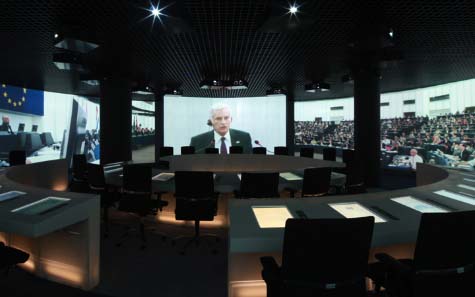November 3, 2011 – Beginning 14th of October, the European Parliament will welcome its visitors with a scenographically staged exhibition in 23 different languages. Planned and designed by Atelier Brückner, the Parlamentarium will present the history of the European Union. It will also provide a transparent, informative and experience-orientated explanation of the European Parliament’s function and how it works in practice.
Situated in a prominent location at Esplanade Solidarnosc in the European quarter in Brussels, the Willy Brandt Building houses around 3,000 square metres of exhibition space designed by the Stuttgart architects. A highly varied presentation spread out over three floors holds the visitor’s attention. It consists of carefully harmonised narrative spaces, which lend three-dimensional expression to the contents of the exhibition.
Parlamentarium Brüssel, A Parliament for Europe, 360 Degree Projection. Photo: Rainer Rehfeld.
A time tunnel serves as a guide through the history of European integration, whereby two circular rooms allow the visitor to become immersed in appropriately staged settings incorporating films shown on the walls in a 360 degree circuit. They impressively convey how the European Parliament and its 736 members work and how varied everyday life is on the culture-rich continent of Europe, where 500 million EU citizens have their home.
Parlamentarium Brüssel, United in Diversity. Photo: Rainer Rehfeld.
The heart of the exhibition is the room entitled “United in Diversity”. A characterising feature of this narrative space is a walk-on map spread out over the floor, showing a Europe without borders. Visitors can explore this Europe by means of mobile “ground-of-stories scanners” and investigate the depths of information provided by the map at diverse so-called “hot spots”. They interactively acquire information on events that caused the European Parliament to draw up regulations that are valid and applicable throughout Europe. One example is the Seveso directives, which were ratified after the dioxine accident in Seveso, northern Italy, in 1976. Europe presents itself as a united entity.
In contrast, the light installation entitled “Sky of Opinions”, which hovers above the map, reflects the very different attitudes of Europeans with regard to individual social, cultural and economic issues. Genetically modified foodstuffs, for example, are approved to different extents in the individual countries. The light map shows this three-dimensionally in that more or few coloured LED spheres light up. It thus becomes clear how much variety is possible within a unified Europe.
The Parlamentarium conveys the motto of the European Union, “United in Diversity”, in an emotional manner. The graphic concept also takes up this guiding idea by showing the same captions in different languages. In each case, the text in another language is displayed in the foreground. Visitors can choose from this variety and call up their favourite version by means of a personalised media guide.
Every EU citizen is addressed in his/her own native language, whereby each item of information is provided in 23 languages. In addition, guidance systems in sign language, audio-descriptive offers and special options encouraging children to acquire information are available. A visit to the Parlamentarium becomes an informative experience for all visitor groups. Intuitively, they submerse themselves in the contents of the exhibition and can interactively gain access to more detailed levels of information.
Parlamentarium Brüssel, Today and Tomorrow, Detail: Vote Result. Photo: Rainer Rehfeld.
One special feature is directed at school classes, which can book a role playing session (concept by Mediafarm, Norway). This is a playful way of explaining the complex process of legislation. The individual steps within this process are expressed in the narrative space. Colourful party cells (yellow, grey, magenta and green) are surrounded by small screens on which the opinions of individual citizens or lobbyists are displayed. Rooms for parliamentary groups and a plenary chamber are also provided. Young people learn how to speak in front of an audience, discuss a topic constructively, accept compromises when necessary, make decisions and stand up for their political opinions. In other words, they learn what it means to actively participate in the idea of a united Europe.
In 2008, Atelier Brückner was given the task of drawing up the general plans for the Parlamentarium. This was subsequent to a competition that had invited submissions from all over Europe; the media had been designed by Atelier Brückner in cooperation with jangled nerves, Stuttgart; the graphics with integral ruedi baur, Berlin. Media production: Markenfilm Crossing, Hamburg; Media Guide: Nous, Vienna.
Information about opening hours and much more you will find on the website of the Parlamentarium.
We reported several times on projects of Atelier Brückner:
– an exhibition in Rome on the foundation of the modern state Italy and ist new currency
– the newly designed National Maritime Museum in Amsterdam






